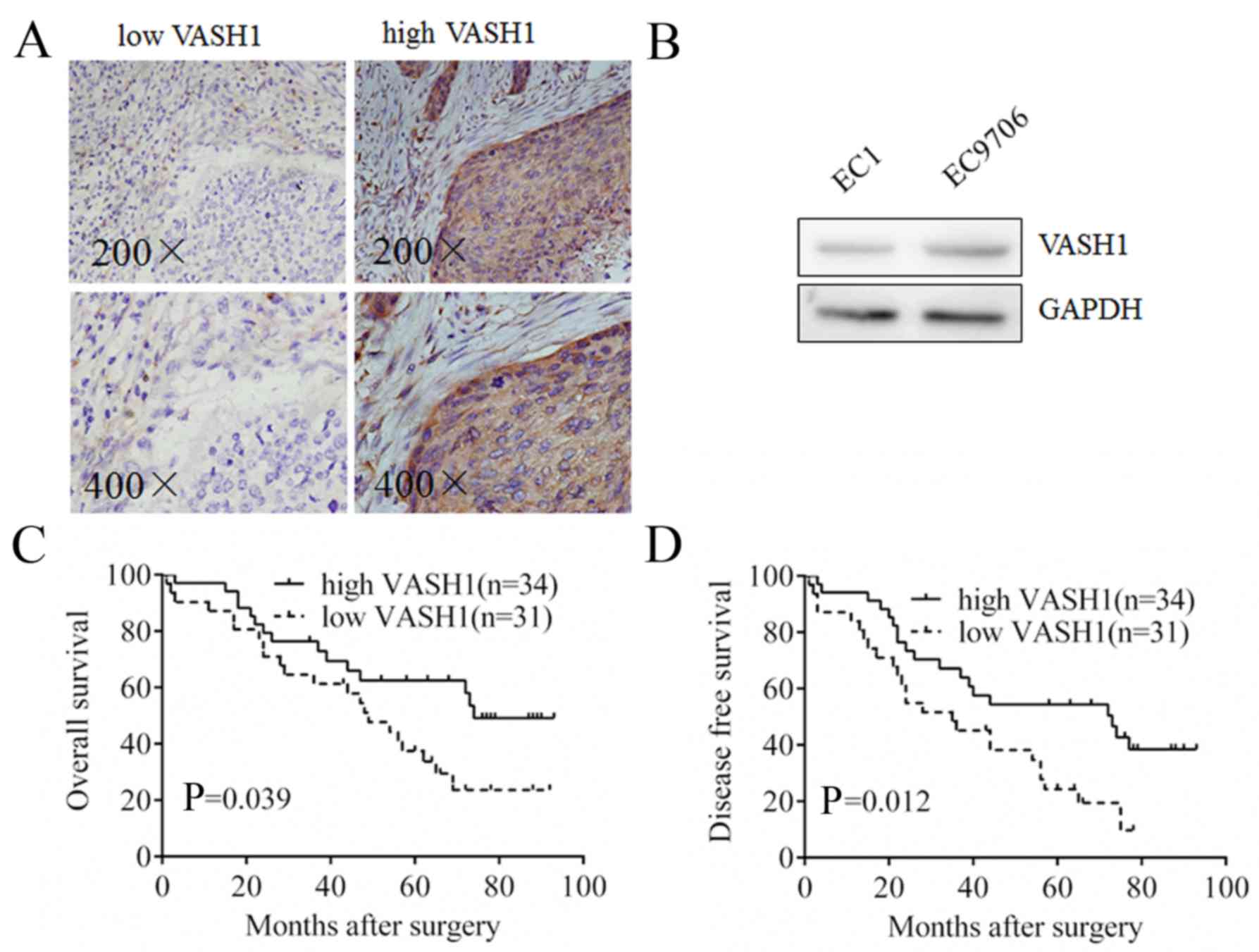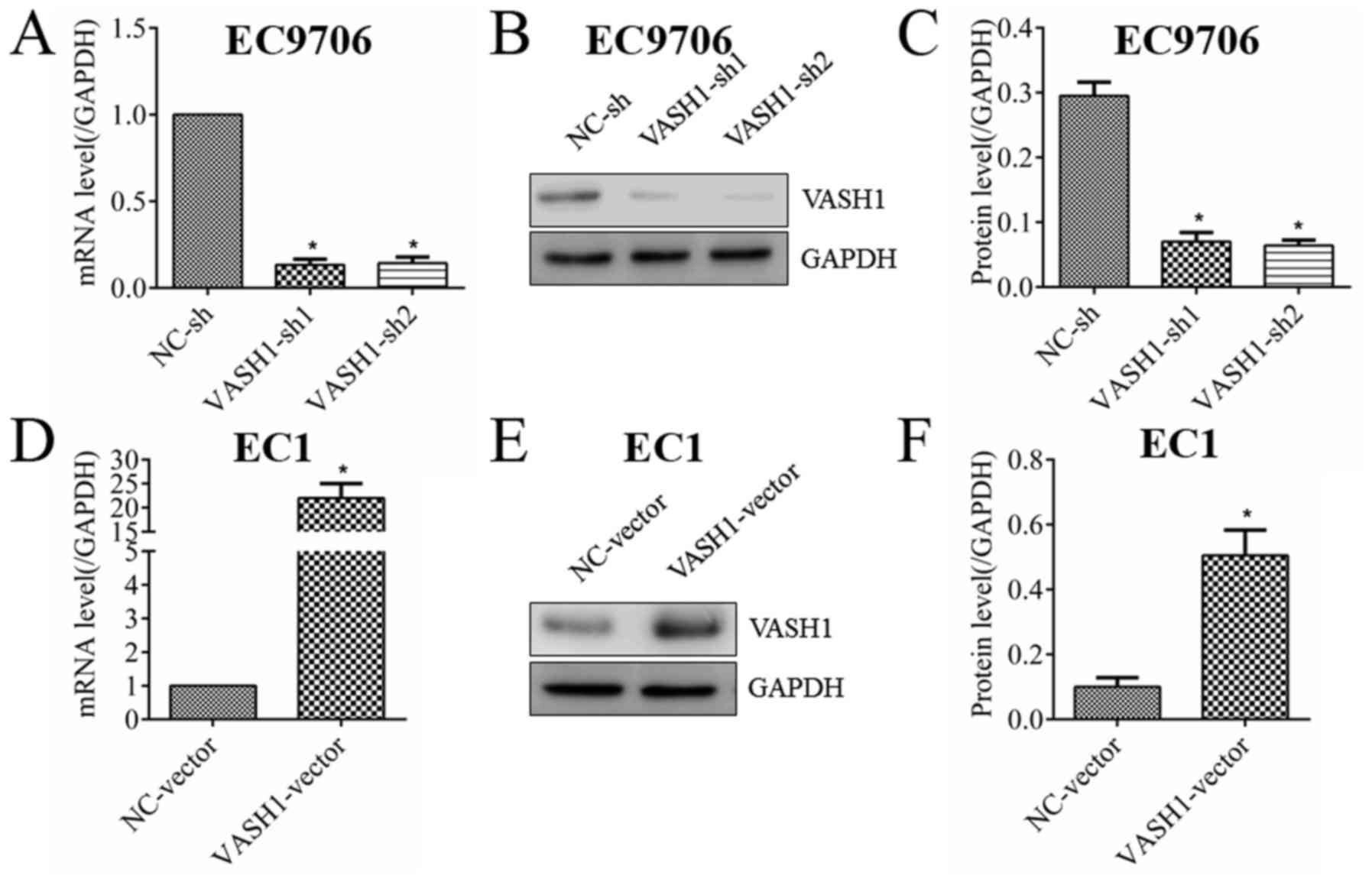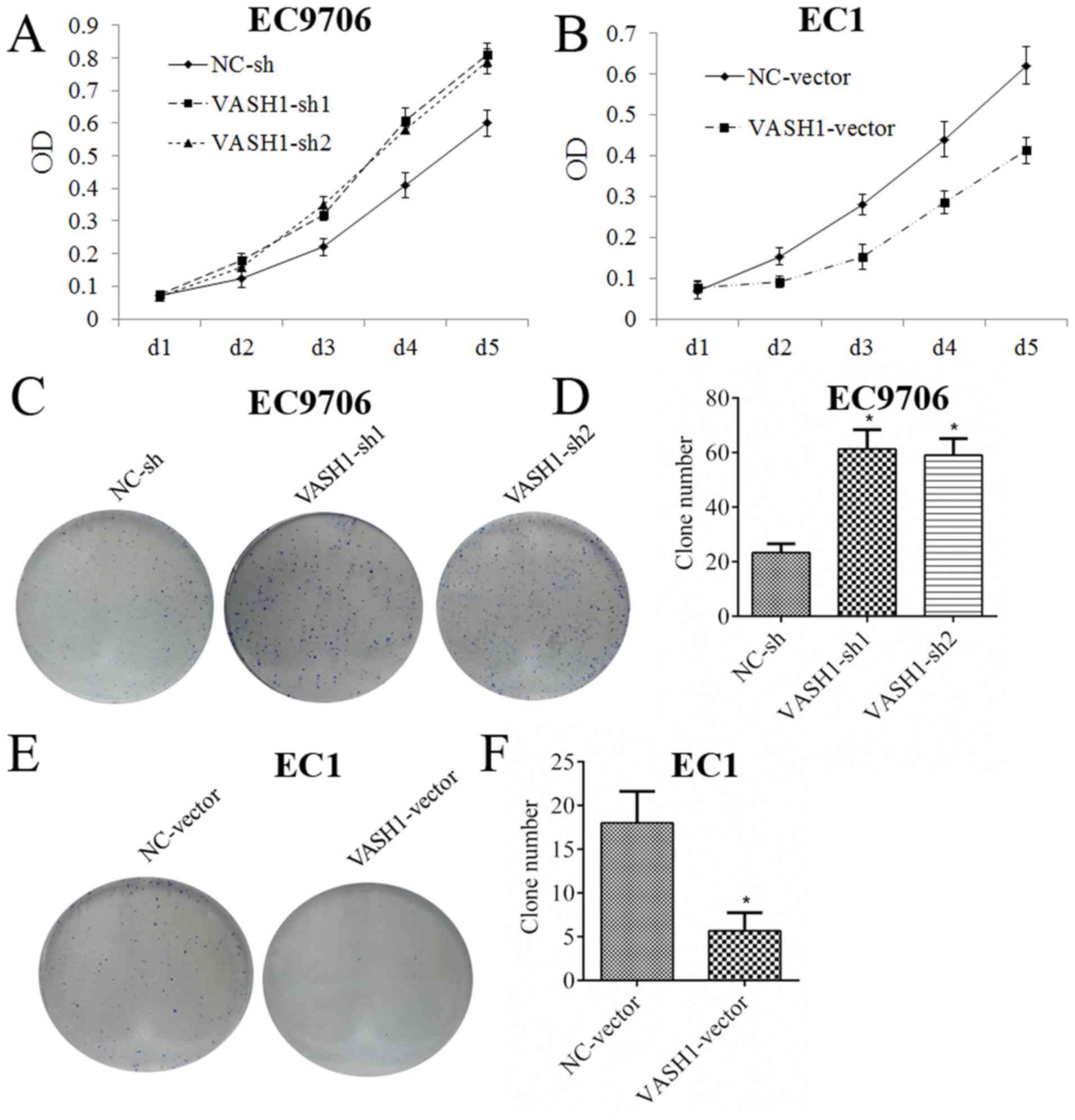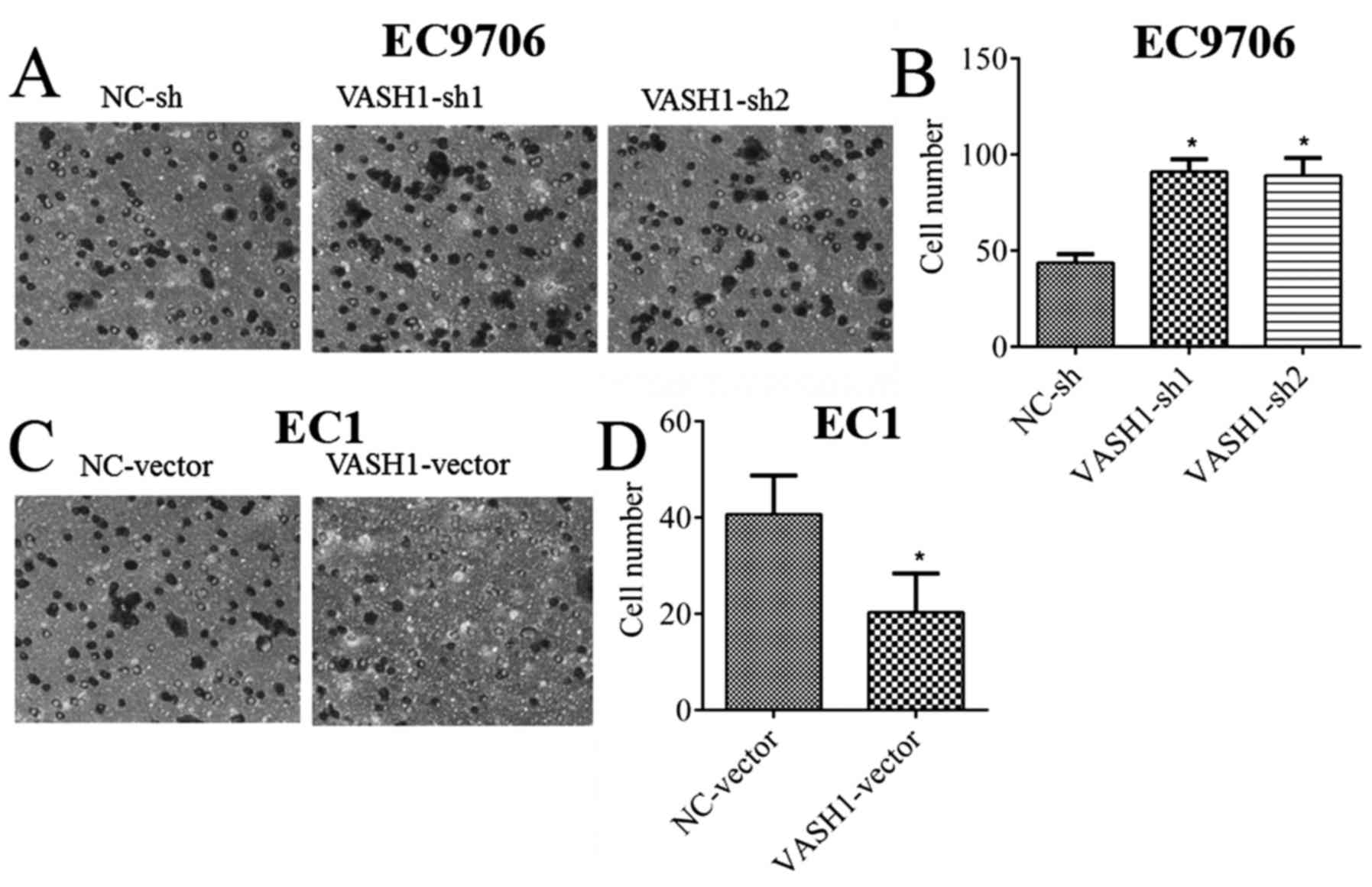Clinical implications of vasohibin-1 in esophageal carcinoma cells: Inhibition of cell growth and migration
- Authors:
- Published online on: June 8, 2017 https://doi.org/10.3892/mmr.2017.6726
- Pages: 1479-1485
Abstract
Introduction
Esophageal carcinoma (EC) is among the most common types of malignancy worldwide, with the 8th highest incidence, and is the 6th leading cause of cancer-associated mortality (1–3). Despite the development of a combination of surgery, radiotherapy and chemotherapy, the prognosis for EC remains poor due to the insidious symptomatology, late clinical presentation and rapid progression (4,5). Therefore, it is necessary to understand the pathophysiological mechanisms underlying the progression of EC and to elucidate novel targets which are able to inhibit the malignant processes, so as to provide an improved prognosis for patients with EC.
Vasohibin-1 (VASH1) is a member of the vasohibin family. Previous studies have reported that VASH1 is selectively expressed in endothelial cells, and is able to inhibit angiogenesis by regulating endothelial cell death and biological functions (6–8). Cumulative evidence has indicated that VASH1 in the tumor mesenchyme may function as a molecular marker for prognosis in numerous types of cancer, including breast cancer (9), renal carcinoma (10), hepatocellular cancer (11) and prostate cancer (12). Previous studies have demonstrated that VASH1 is not restricted to endothelial cells, and is additionally expressed in other types of cells, including tumor cells (13,14). However, the expression of VASH1 in EC cells and the relevance of this to clinical parameters and prognosis remains unknown. The direct effect of VASH1 on the biological behaviors of EC cells has not been reported.
The present study demonstrated the expression of VASH1 in EC cells using immunohistochemistry (IHC) and western blotting, and it was observed that increased VASH1 expression was negatively correlated with tumor size, invasion depth and poor prognosis. Following alteration of VASH1 expression in EC cells using transfection, it was observed that VASH1 markedly inhibited the proliferation, clone formation and migration of EC cells. The results of the present study demonstrated the suppressive effects of VASH1 in EC and provide evidence of a novel target to inhibit EC progression.
Materials and methods
Cell lines and culture
EC cell lines EC1 and EC9706 were purchased from the American Type Culture Collection (Manassas, VA, USA). EC1 and EC9706 cells were cultured in RPMI-1640 medium (Invitrogen; Thermo Fisher Scientific, Inc., Waltham, MA, USA) supplemented with 10% fetal bovine serum (FBS; Invitrogen; Thermo Fisher Scientific, Inc.) at 37°C in 5% CO2.
IHC
Approved by the Review Board and Ethics Committee of Yishui Central Hospital of Lingyi (Lingyi, China), 100 primary EC specimens obtained between January 2006 and January 2009 were selected from the hospital. No chemotherapy, radiotherapy or immunotherapy had been performed prior to surgery. Patient characteristics are presented in Table I.
Paraffin-embedded tissue samples were cut into 4-µm slices. Then, the slides were kept at 60°C for 30 min, de-paraffinized in xylene at room temperature and rehydrated in graded ethanol. Following antigen unmasking, the sections were immersed in 3% H2O2 for 10 min to inhibit the endogenous peroxidase and in goat serum blocking solution (Fuzhou Maixin Biotech Co., Ltd., Fuzhou, China) at room temperature for 15 min to block non-specific antigens. Following incubation at room temperature for 2 h with primary antibody against VASH1 (1:600; Abnova, Taipei, Taiwan), the sections were incubated in horseradish peroxidase goat anti-rabbit/mouse immunoglobulin G polymer (cat. no. KIT-7710; Fuzhou Maixin Biotech Co., Ltd.) at room temperature for 30 min. The slides were stained with 3,3′-diaminobenzidine for 5–10 sec and counterstained with hematoxylin for 20 sec at room temperature. The staining assessment was performed by two independent pathologists simultaneously at ×400 magnification using an Olympus BX53 light microscope (Olympus Corporation, Tokyo, Japan). The proportion score represented the estimated fraction of positive staining tumor cells (0, ≤25%; 1, 26–50%; 2, 51–75%; 3, >75%). The intensity score represented the estimated average staining intensity of positive tumor cells (0, negative; 1, weak; 2, moderate; 3, strong). The expression level of VASH1 was evaluated using the product of the proportion score and intensity score at five fields and the mean value was obtained (low expression, ≤4; high expression, >4). The overall survival (OS) period was defined as the period of time from surgery to cell death induced by different factors. Disease-free survival (DFS) was defined as the period of time from surgery to the recurrence or progression of disease.
Transfection
Plasmid pEZ-M61/VASH1 (Shanghai Gene Pharma Co., Ltd, Shanghai, China) was transfected into EC1 cells to upregulate VASH1 expression; p-GPU6/VASH1-sh1/2 (Shanghai GenePharma Co., Ltd) was transfected into EC9706 cells to downregulate VASH1 expression. All procedures were performed using Lipofectamine 2000 (Invitrogen; Thermo Fisher Scientific, Inc.) according to the manufacturer's protocol, and empty vectors were used as a control. Cells were harvested 48 h subsequently and transfection efficiency was determined using reverse transcription-quantitative polymerase chain reaction and western blotting. The two shRNA sequences used for silencing VASH1 were as follows: shRNA1, 5′-AGCGCTACATCAGAGAGCTGCAGTA-3′; shRNA 2, 5′-CCTACTTCTCAGGGAACTACT-3′.
RT-qPCR
Cells were collected and total RNA was extracted using TRIzol (Invitrogen; Thermo Fisher Scientific, Inc.). cDNA was synthesized as a template using PrimeScript RT-PCR kit (Takara Biotechnology Co. Ltd., Dalian, China), according to the manufacturer's protocol. The qPCR was performed using specific primers and Universal PCR Master Mix (Thermo Fisher Scientific, Inc.) with a CFX96 Touch Deep Well™ Real-Time PCR Detection System (Bio-Rad Laboratories, Inc., Hercules, CA, USA) with the following thermocycling conditions: VASH1; 4°C for 5 min, then 40 cycles of 94°C for 30 sec, 57°C for 30 sec and 72°C for 30 sec, followed by 72°C for 5 min; the same thermocycling conditions were applied for GAPDH, however, 36 cycles were performed instead of 40. mRNA levels were normalized to GAPDH. The primers were as follows: VASH1: forward, 5′-CAAGGACCGGAAGAAGGAUGUUUCU-3′ and reverse, 5′-CAACCAAGGAGAGGAGUAUUGGUCU-3′; and GAPDH: forward, 5′-AGAAGGCTGGGGCTCATTTG-3′ and reverse, 5′-AGGGGCCATCCACAGTCTTC-3′. The 2−ΔΔCq method was used for quantification (15). The experiment was performed ≥3 times.
Western blot
Protein was extracted from cells using radioimmunoprecipitation lysis buffer containing 1% PMSF (Beyotime Institute of Biotechnology, Haimen, China) and the concentration was detected using a bicinchoninic acid kit (Pierce; Thermo Fisher Scientific, Inc.). A total of 300 mg/well protein was loaded into a 5% SDS-PAGE gel and then separated by a 10% separating gel and transferred to polyvinylidene difluoride membrane. Following blocking in TBS with Tween-20 containing 5% non-fat dried milk for 1 h at room temperature, the membrane was incubated in primary antibodies of VASH1 (1:1,000) and GAPDH (cat. no. 10494-1-AP; 1:5,000, Proteintech Group, Inc., Wuhan, China) at 4°C overnight. Following incubation with horseradish peroxidase-conjugated secondary antibody (cat. no. SA00001-2; 1:5,000, Proteintech Group, Inc.) at room temperature for 1 h, the protein on the membrane was detected using a chemiluminescence solution (EMD Millipore, Billerica, MA, USA) according to the manufacturer's instructions, and measured using Image-Pro software (version 5.1; Media Cybernetics, Inc., Rockville, MA, USA).
Viability assay
An MTT assay was used to detect viability. Cells were counted and plated in 96-well plates in triplicate at a starting number of 3×103 cells/well. The absorbance of each sample was measured at 490 nm for 5 days using MTT (Beijing Solarbio Science and Technology Co., Ltd., Beijing, China) according to the manufacturer's protocol. The experiment was repeated 3 times.
Clone formation assay
Cells were plated in 6-well plates at 1,000 cells/well. After 2 weeks, cell colonies were stained using giemsa at room temperature for 15 min (Beijing Solarbio Science and Technology Co., Ltd.) and counted under a light microscope (magnification, ×200; >50 cells as one clone; XDS-200; Olympus Corporation). The experiment was repeated three times.
Migration assay
A total of 1×105 cells were plated in the upper chambers of Transwell plates in RPMI-1640 without FBS. RPMI 1640 supplemented by 20% FBS was plated in the lower chamber. Following incubation for 24 h, migrated cells were fixed using 100% methanol at room temperature for 30 min, stained with 0.1% crystal violet at room temperature for 25 min and counted in five random fields at ×200 magnification.
Statistical analysis
All data are expressed as the mean ± standard error of the mean and SPSS software (version 13.0; SPSS, Inc., Chicago, IL, USA) was used for the statistical analysis. The differences between two groups were analyzed using the Student's two-tailed t-test. The associations between the expression of VASH1 and clinical parameters were analyzed using Pearson's χ2 test. Survival curves were drawn using the Kaplan-Meier estimator method and compared by means of the log-rank test. P<0.05 was considered to indicate a statistically significant difference.
Results
Increased VASH1 expression in EC cells is negatively correlated with tumor size, invasion depth and poor prognosis
In order to detect VASH1 expression in EC tissues, IHC was performed and it was observed that VASH1 was expressed in the cytoplasm of EC cells with different staining intensities; sporadic staining was observed in the mesenchyme (Fig. 1A). Different expression levels of VASH1 were observed in EC1 cells and EC9706 cells using western blotting (Fig. 1B). Due to the important roles of mesenchymal VASH1 in tumor progression, the correlation between VASH1 in EC cells and clinical parameters was analyzed. As presented in Table I, in the VASH1 high expression group, 12/42 cases exhibited a tumor size of ≥5 cm; in the VASH1 low expression group, 40/58 cases exhibited a tumor size of ≥5 cm (P<0.001). In the VASH1 high expression group, 14/42 cases were at T3/4 stage; in the VASH1 low expression group, 38/58 cases were at T3/4 stage (P=0.001). Survival analysis demonstrated that the OS period of VASH1 high expression group was increased compared with the VASH1 low expression group (P=0.039; Fig. 1C); additionally, the DFS period of the VASH1 high expression group was increased compared with the VASH1 low expression group (P=0.012, Fig. 1D). The results of the present study confirmed that VASH1 in EC cells exhibited a negative correlation with progression and poor prognosis for patients with EC.
VASH1 inhibits the proliferative ability of EC cells
In order to study the direct effect of VASH1 on EC cells, the expression of VASH1 in EC cells was altered using transfection. As presented in Fig. 2, VASH1 in EC9706 cells was successfully downregulated at the RNA (Fig. 2A) and protein (Fig. 2B and C) levels; VASH1 in EC1 cells was successfully upregulated at the RNA (Fig. 2D) and protein (Fig. 2E and F) levels. MTT and clone formation assays are presented in Fig. 3. Following downregulation of VASH1 in EC9706 cells, the MTT assay demonstrated that the growth rate increased markedly (Fig. 3A); the clone formation assay demonstrated that clone number increased from 23.33±3.21 to 61.33±7.02 or 59.00±6.08 (P<0.05; Fig. 3C and D). Following upregulation of VASH1 in EC1 cells, the MTT assay demonstrated that growth rate decreased markedly (Fig. 3B); the clone formation assay demonstrated that clone number decreased from 18.00±3.60 to 5.66±2.08 (P<0.05; Fig. 3E and F). The results of the present study demonstrated that VASH1 was able to directly inhibit the growth of EC cells.
VASH1 inhibits the migration of EC cells
Migratory ability is an important biological behavior of tumor cells and serves important roles in cancer invasion and metastasis (16,17). In order to detect the direct effect of VASH1 on the migratory ability of EC cells, a migration assay was performed; it was demonstrated that, following downregulation of VASH1 in EC9706 cells, the number of migratory cells increased from 43.66±4.51 to 91.00±6.55 or 89±9.16 (P<0.05; Fig. 4A and B). Following upregulation of VASH1 in EC1 cells, the number of migratory cells decreased from 40.66±8.08 to 20.33±8.02 (P<0.05; Fig. 4C and D). The results of the present study demonstrated the negative regulatory effect of VASH1 on the migratory ability of EC cells.
Discussion
The human VASH1 gene is located on chromosome 14q24.3, including 8 exons and 7 introns. Human VASH1 protein is composed of 365 amino acids with no glycosylation sites (18,19). As an acknowledged negative feedback regulator of angiogenesis, the anti-tumor function of mesenchymal VASH1 has been widely reported in multiple types of cancer (7,20,21). Kosaka et al (12) observed that VASH1 expression was restricted in the mesenchyme and negatively correlated with advanced clinical stage and poor recurrence-free survival of prostate cancer patients. Tamaki et al (9) reported that VASH1 was detected in human breast cancer endothelial cells and positively correlated with poor OS and DFS of patients. VASH1 expression has additionally been detected in parenchymal cells of several types of tumor. However, the roles of parenchymal VASH1 in cancer remains controversial. Zhao et al (10) reported that VASH1 was expressed primarily in the cytoplasm and on the membrane of renal cell carcinoma cells, and exhibited a negative correlation with tumor malignancy. In hepatocellular carcinoma, Wang et al (11) demonstrated that increased expression of VASH1 in the cytoplasm was positively-correlated with poor prognosis. In the present study, the expression of VASH1 in EC cells was observed using IHC and western blotting, and the results of the present study are consistent with the distribution of VASH1 in renal cell carcinoma and hepatocellular carcinoma reported by Zhao et al (10) and Wang et al (11). Further analysis demonstrated that VASH1 in EC cells was negatively correlated with tumor size, invasion depth and poor prognosis (OS and DFS); this is in contrast with the study of Wang et al and suggests that VASH1 exhibits anti-tumor effects in EC cells. Only 100 primary EC specimens were used in the present study; due to this limitation, the results of the present study may not completely reflect the clinical implications of VASH1 in EC.
Initial studies hypothesized that the anti-tumor effects of VASH1 were primarily mediated by inhibition of angiogenesis. The potential direct effects of VASH1 on tumor cells remain to be elucidated. Increased growth and migratory abilities are classical biological behaviors of malignant tumors, and are crucial for tumor occurrence, invasion, metastasis and prognosis (22–25). Conflicting reports about the direct effects of VASH1 on biologic behaviors of tumor cells have been published. Watanabe et al (7) reported that, although overexpression of VASH1 in lung cancer cells successfully inhibited angiogenesis in vivo, no effects on the proliferative ability of cancer cells were observed in vitro. By contrast, Liu et al (26) demonstrated that overexpression of VASH1 in colorectal cancer cells was able to inhibit growth and migration. Due to the results of the IHC in the present study, demonstrating that VASH1 was negatively correlated with tumor size and invasion depth, it was hypothesized that VASH1 may affect the growth and migration of EC cells directly. In order to examine this hypothesis, VASH1 expression in EC cells was altered using transfection and it was observed that overexpression of VASH1 inhibited proliferation, clone formation and the migratory ability of EC1 cells; however, silencing VASH1 enhanced proliferation, clone formation and the migratory ability of EC9706 cells. The results of the present study demonstrated the direct inhibitory effects of VASH1 on the growth and migration of EC cells, consistent with the inhibition of VASH1 on colorectal cancer cells reported by Liu et al (26). The results of the present study suggest that the negative correlation of VASH1 with EC progression and prognosis may be partially attributed to a direct effect on EC cells.
However, tumor growth is a complex process and may be regulated by various events, including proliferation, cell cycle progression, apoptosis and angiogenesis (27,28). Apart from proliferation and angiogenesis, Liu et al (26) has also observed that VASH1 was able to effectively promote apoptosis and senescence in CRC cells. However, apoptosis and senescence of EC cells were not investigated in the present study. Tumor invasion is a process which may be affected by the motility of tumor cells and degradation of the extracellular matrix by proteases produced in tumor cells (29,30). Although the results of the present study demonstrated the inhibitory effect of VASH1 on EC cell migration, this is insufficient to explain the negative correlation of VASH1 with EC invasion depth. It is possible that VASH1 may additionally affect the production of certain types of protease, including matrix metalloproteinase or collagenase, in EC cells; further research is required to investigate this hypothesis.
In conclusion, VASH1 in EC cells was negatively correlated with tumor size, invasion depth and poor prognosis. VASH1 is able to prevent EC progression by anti-angiogenesis, and additionally through direct inhibition of the growth and migration of EC cells. The results of the present study increase the understanding of VASH1 in the context of tumors and contribute to the search for improved treatments for EC.
References
|
Zhang H, Chen W, Duan CJ and Zhang CF: Overexpression of HSPA2 is correlated with poor prognosis in esophageal squamous cell carcinoma. World J Surg Oncol. 11:1412013. View Article : Google Scholar : PubMed/NCBI | |
|
Zhu YH, Yang F, Zhang SS, Zeng TT, Xie X and Guan XY: High expression of biglycan is associated with poor prognosis in patients with esophageal squamous cell carcinoma. Int J Clin Exp Pathol. 6:2497–2505. 2013.PubMed/NCBI | |
|
Li M, Yang X, Zhang J, Shi H, Hang Q, Huang X, Liu G, Zhu J, He S and Wang H: Effects of EHD2 interference on migration of esophageal squamous cell carcinoma. Med Oncol. 30:3962013. View Article : Google Scholar : PubMed/NCBI | |
|
Hasan MR, Sharma R, Saraya A, Chattopadhyay TK, DattaGupta S, Walfish PG, Chauhan SS and Ralhan R: Slug is a predictor of poor prognosis in esophageal squamous cell carcinoma patients. PLoS One. 8:e828462013. View Article : Google Scholar : PubMed/NCBI | |
|
Kim SG: What is the next step after endoscopic resection of superficial esophageal squamous cell carcinoma? Gut Liver. 9:693–694. 2015. View Article : Google Scholar : PubMed/NCBI | |
|
Kern J, Steurer M, Gastl G, Gunsilius E and Untergasser G: Vasohibin inhibits angiogenic sprouting in vitro and supports vascular maturation processes in vivo. BMC Cancer. 9:2842009. View Article : Google Scholar : PubMed/NCBI | |
|
Watanabe K, Hasegawa Y, Yamashita H, Shimizu K, Ding Y, Abe M, Ohta H, Imagawa K, Hojo K, Maki H, et al: Vasohibin as an endothelium-derived negative feedback regulator of angiogenesis. J Clin Invest. 114:898–907. 2004. View Article : Google Scholar : PubMed/NCBI | |
|
Sato Y: The vasohibin family. Pharmaceuticals. 3:433–440. 2010. View Article : Google Scholar : PubMed/NCBI | |
|
Tamaki K, Moriya T, Sato Y, Ishida T, Maruo Y, Yoshinaga K, Ohuchi N and Sasano H: Vasohibin-1 in human breast carcinoma: A potential negative feedback regulator of angiogenesis. Cancer Sci. 100:88–94. 2009. View Article : Google Scholar : PubMed/NCBI | |
|
Zhao G, Yang Y, Tang Y, Han R and Sun Y: Reduced expression of vasohibin-1 is associated with clinicopathological features in renal cell carcinoma. Med Oncol. 29:3325–3334. 2012. View Article : Google Scholar : PubMed/NCBI | |
|
Wang Q, Tian X, Zhang C and Wang Q: Upregulation of vasohibin-1 expression with angiogenesis and poor prognosis of hepatocellular carcinoma after curative surgery. Med Oncol. 29:2727–2736. 2012. View Article : Google Scholar : PubMed/NCBI | |
|
Kosaka T, Miyazaki Y, Miyajima A, Mikami S, Hayashi Y, Tanaka N, Nagata H, Kikuchi E, Nakagawa K, Okada Y, et al: The prognostic significance of vasohibin-1 expression in patients with prostate cancer. Br J Cancer. 108:2123–2129. 2013. View Article : Google Scholar : PubMed/NCBI | |
|
Kimura H, Miyashita H, Suzuki Y, Kobayashi M, Watanabe K, Sonoda H, Ohta H, Fujiwara T, Shimosegawa T and Sato Y: Distinctive localization and opposed roles of vasohibin-1 and vasohibin-2 in the regulation of angiogenesis. Blood. 113:4810–4818. 2009. View Article : Google Scholar : PubMed/NCBI | |
|
Shen Z, Seppänen H, Kauttu T, Vainionpää S, Ye Y, Wang S, Mustonen H and Puolakkainen P: Vasohibin-1 expression is regulated by transforming growth factor-β/bone morphogenic protein signaling pathway between tumor-associated macrophages and pancreatic cancer cells. J Interferon Cytokine Res. 33:428–433. 2013. View Article : Google Scholar : PubMed/NCBI | |
|
Livak KJ and Schmittgen TD: Analysis of relative gene expression data using real-time quantitative PCR and the 2(−Delta Delta C(T)) Method. Methods. 25:402–408. 2001. View Article : Google Scholar : PubMed/NCBI | |
|
Jiang YX, Du ZM, Jiao L, Shao Q, Fu S, Shao JY, Zhu XF, Ernberg I and Li YH: Inhibition of MiR-155 suppresses cell migration in nasopharyngeal carcinoma through targeting ZDHHC2. Int J Clin Exp Med. 8:8472–8484. 2015.PubMed/NCBI | |
|
Zhang Y and Lin Q: MicroRNA-145 inhibits migration and invasion by down-regulating FSCN1 in lung cancer. Int J Clin Exp Med. 8:8794–8802. 2015.PubMed/NCBI | |
|
Zhang T, Yu TT, Zhang DM, Hou XM, Liu XJ, Zhao D and Shan L: Vasohibin-1 expression detected by immunohistochemistry correlates with prognosis in non-small cell lung cancer. Med Oncol. 31:9632014. View Article : Google Scholar : PubMed/NCBI | |
|
Yan Y, Shen Z, Ye Y, Jiang K, Zhang H, Shen C, Mustonen H, Puolakkainen P and Wang S: A novel molecular marker of prognosis in colorectal cancer: Vasohibin-1. Med Oncol. 31:8162014. View Article : Google Scholar : PubMed/NCBI | |
|
Miyashita H, Watanabe T, Hayashi H, Suzuki Y, Nakamura T, Ito S, Ono M, Hoshikawa Y, Okada Y, Kondo T and Sato Y: Angiogenesis inhibitor vasohibin-1 enhances stress resistance of endothelial cells via induction of SOD2 and SIRT1. PLoS One. 7:e464592012. View Article : Google Scholar : PubMed/NCBI | |
|
Miyashita H, Suzuki H, Ohkuchi A and Sato Y: Mutual balance between vasohibin-1 and soluble VEGFR-1 in endothelial cells. Pharmaceuticals (Basel). 4:782–793. 2011. View Article : Google Scholar : | |
|
Lv ZD, Zhang L, Liu XP, Jin LY, Dong Q, Li FN, Wang HB and Kong B: NKD1 down-regulation is associated with poor prognosis in breast invasive ductal carcinoma. Int J Clin Exp Pathol. 8:4015–4021. 2015.PubMed/NCBI | |
|
Shen Y, Zhang F, Lan H, Chen K, Zhang Q, Xie G, Teng L and Jin K: FRZB up-regulation is correlated with hepatic metastasis and poor prognosis in colon carcinoma patients with hepatic metastasis. Int J Clin Exp Pathol. 8:4083–4090. 2015.PubMed/NCBI | |
|
Strong AL, Ohlstein JF, Biagas BA, Rhodes LV, Pei DT, Tucker HA, Llamas C, Bowles AC, Dutreil MF, Zhang S, et al: Leptin produced by obese adipose stromal/stem cells enhances proliferation and metastasis of estrogen receptor positive breast cancers. Breast Cancer Res. 17:1122015. View Article : Google Scholar : PubMed/NCBI | |
|
Pathak R, Philizaire M and Mujtaba S: Dichotomy in the Epigenetic Mark Lysine Acetylation is Critical for the Proliferation of Prostate Cancer Cells. Cancers (Basel). 7:1622–1642. 2015. View Article : Google Scholar : PubMed/NCBI | |
|
Liu S, Han B, Zhang Q, Dou J, Wang F, Lin W, Sun Y and Peng G: Vasohibin-1 suppresses colon cancer. Oncotarget. 6:7880–7898. 2015. View Article : Google Scholar : PubMed/NCBI | |
|
Rusckowski M, Wang Y, Blankenberg FG, Levashova Z, Backer MV and Backer JM: Targeted scVEGF/(177)Lu radiopharmaceutical inhibits growth of metastases and can be effectively combined with chemotherapy. EJNMMI Res. 6:42016. View Article : Google Scholar : PubMed/NCBI | |
|
Vanajothi R and Srinivasan P: An anthraquinone derivative from Luffa acutangula induces apoptosis in human lung cancer cell line NCI-H460 through p53-dependent pathway. J Recept Signal Transduct Res. 36:292–302. 2016. View Article : Google Scholar : PubMed/NCBI | |
|
Qiu K, Huang Z, Huang Z, He Z and You S: miR-22 regulates cell invasion, migration and proliferation in vitro through inhibiting CD147 expression in tongue squamous cell carcinoma. Arch Oral Biol. 66:92–97. 2016. View Article : Google Scholar : PubMed/NCBI | |
|
Chen JS, Li HS, Huang JQ, Dong SH, Huang ZJ, Yi W, Zhan GF, Feng JT, Sun JC and Huang XH: MicroRNA-379-5p inhibits tumor invasion and metastasis by targeting FAK/AKT signaling in hepatocellular carcinoma. Cancer Lett. 375:73–83. 2016. View Article : Google Scholar : PubMed/NCBI |













